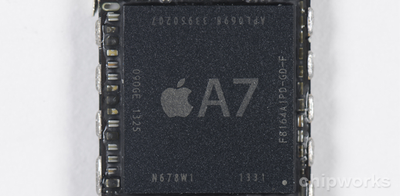According to Taiwan's Economic Daily News [Google Translate, via Digitimes], Apple's reported current A-series chip partner Taiwan Semiconductor Manufacturing Company (TSMC) is ahead of schedule with its next-generation 16nm process for chip production. The Chinese-language report claims TSMC will begin 16nm volume production in Q1 2015, a full quarter earlier than its originally projected Q2 2015 start. This advancement may pave the way for TSMC to supply Apple with the future A9 processor that would be used in the late 2015 iPhone.

TSMC is reportedly installing this 16mm capability in its manufacturing plants with the potential for a monthly output of 50,000 wafers. This capability positions TSMC favorably against Samsung as the two companies vie to supply Apple with processors for both its current and future iPhone and iPad models.
Reports from last year suggested Samsung, GlobalFoundries and TSMC would share production of Apple's A9 processor in 2015. Samsung is expected to handle the lion's share of the production, providing up to 40% of Apple's processor supply, although TSMC may be looking to alter that balance with its accelerated work. GlobalFoundries, TSMC and possibly even Intel may be used to complement Samsung's production to provide the remaining chip inventory necessary to meet Apple's demand.
























Top Rated Comments
Says who?
The market certainly wants them. Each time I read a comment like that I wonder what is wrong with humanity.
I don't want a stupid pathetic small screen either, but I'm not stupid so I understand that millions might want it.
The talk of 14nm, 16nm, or even 1nm, is interesting...
Marketing can blur the lines between for example, routing being on say a 16nm basis, and the main structures that make up a transistor being on a larger one, say 20 or 22nm.
The issue of whether there is enough demand to produce enough chips, and spreading across 14nm and 16nm to cope with this perhaps a 'red herring' - with TSMC and others moving from 300mm to 450mm wafers, significantly more devices can be made per wafer, even more so if they are made at 14nm rather than say, 22nm. So the demand issue may be less negative than it seems - the true demand is there, and growing perhaps, but can be met by a smaller number of fabs... which would really reduce operating costs...
The physics of Moore's Law running out at around 5nm may be a non-sequitur in that the financials become the dominating issue around 7nm. The cost of the equipment, fab, and then mask sets for 7nm devices are now so expensive when spread across the devices being built, that it is MORE expensive to build at 7nm say, than at 10-12nm. The development costs at the 7nm node are huge in comparison to at the 20nm node, and 22nm has proven a challenge for Intel, so...
We are probably seeing the practical end of 50+ years of shrinking... and the falsehood of lower costs year after year (lower costs are not the same as lower prices!).
Or, not. http://en.wikipedia.org/wiki/Intel_Tick-Tock There are some fundamental limits of physics we hit ~5nm when using full atoms to create transistors. We need some new (sub-atomic) paradigms to keep Moore's Law going ...
We don't need any stinking phablets from Apple. Or stupidly large iPads.
Also the 24 inch iMac is a thing of the past. Back in the days when 17, 20 and 24 inch iMacs were a thing.